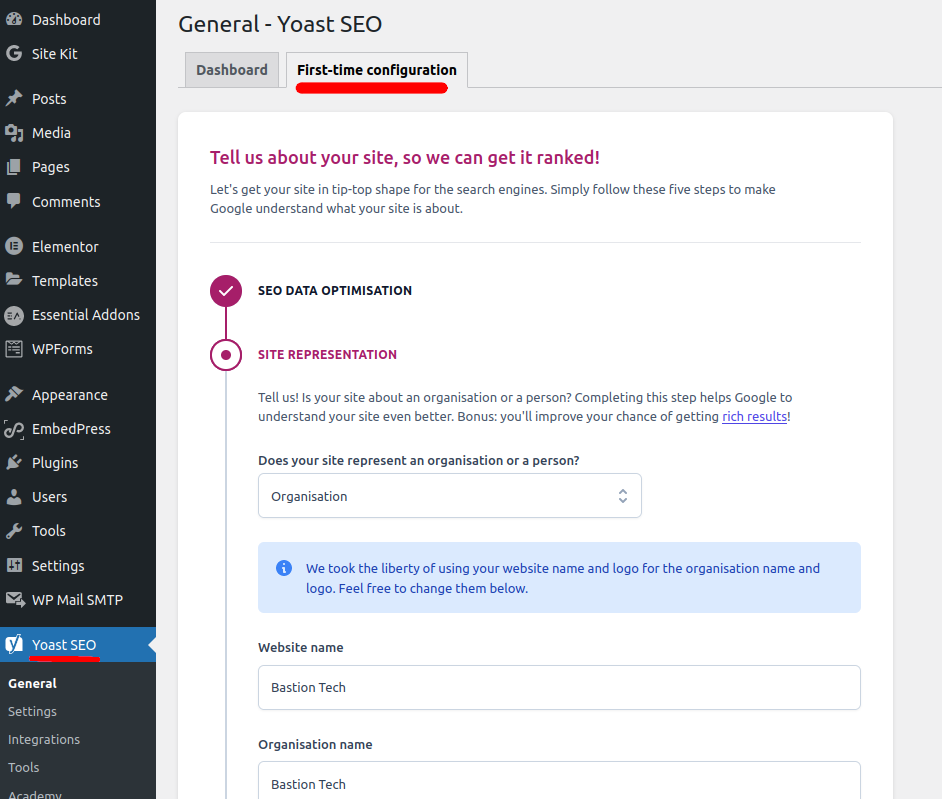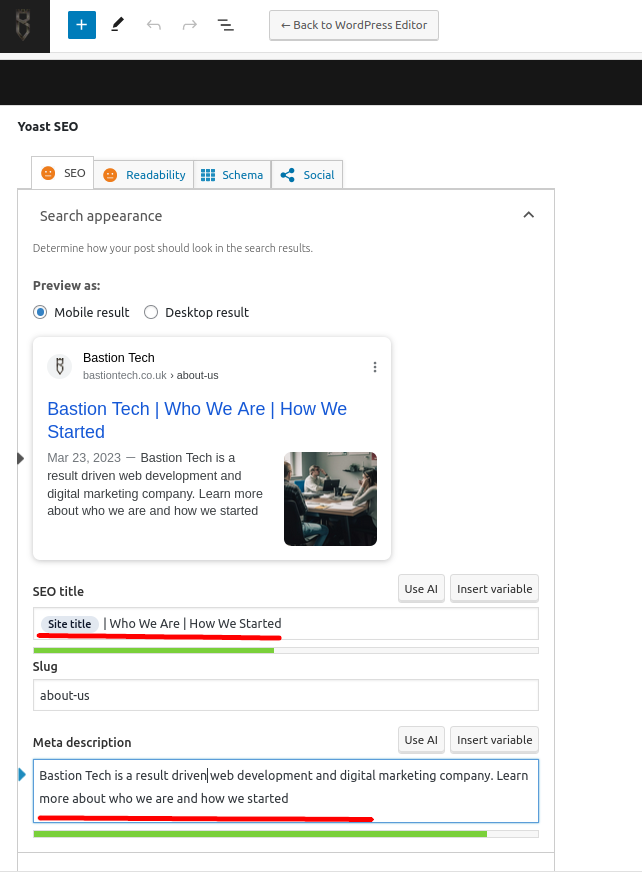Whether you’re running a personal blog, a bustling online store, or a professional portfolio, SEO is a crucial component of your site’s visibility and success.
In this guide, we’ll walk you through the step-by-step process of installing Yoast SEO, configuring its settings for optimal performance, and effectively using the plugin to add meta titles and descriptions to your pages.
How to Add Meta Titles & Descriptions in WordPress
1. Install Yoast SEO Plugin:
In your WordPress dashboard, go to ‘Plugins’, select ‘Add New’, and search for “Yoast SEO”. Install and activate the plugin.
2. Configure Yoast SEO:
Once activated, navigate to the Yoast SEO section in your dashboard. Yoast SEO provides a Configuration Wizard to help you set up the basic settings.
This first-time setup will guide you through, choosing the environment (production, staging, or development), describing your site (blog, webshop, news site, etc.), and setting up social profiles. It’s a streamlined way to ensure the plugin aligns with your site’s objectives.

3. Choose What Page to Edit:
Go to ‘Pages’ in your WordPress dashboard and select a page you want to edit.

4. Add Meta Titles, Descriptions and Images:
Scroll down to the Yoast SEO section below the page editor. Here, you’ll find options to add a meta title and a meta description. These fields allow you to set custom titles and descriptions that will appear in search engine results.
It shows you a suggested length using the green bar below the text input boxes so you know what to aim for. There is even a preview for mobile and desktop so you know what your site will appear like in serps.

Meta Tags for Search Engines and Ranking
Meta data, specifically meta titles and descriptions, play a pivotal role in both search engine optimisation (SEO) and enhancing user experience, which can significantly influence the click-through rate (CTR) from search engine results pages (SERPs).
Relevance and Context
Meta titles and descriptions provide search engines with critical information about the content of a page. This helps search engines understand the relevance of a page to specific search queries, which is essential for ranking purposes.
Keyword Optimisation
By incorporating relevant keywords into the meta title and description, you signal to search engines what the page is about, which can improve its ranking for those terms.
Quality Signals
Well-crafted metadata can also be a quality signal to search engines, suggesting that the website is well-maintained and the content is likely to be of high quality and relevant.
Meta Data’s Impact on User Experience
First Impressions
Meta titles and descriptions are often the first piece of content a user sees when your page appears in search results. A clear and descriptive meta title and description set the right expectations about the content of the page, which improves user experience even before they click the link.
Content Summary
Effective meta descriptions serve as concise summaries of the webpage content, helping users decide quickly whether the content is what they’re looking for. This can enhance user satisfaction because it saves time and effort in finding the right information.
Increasing Click-Through Rate on the SERP
Engagement
A compelling meta title and description can make your listing stand out in the SERPs, increasing the likelihood that users will click on it. Descriptions that effectively communicate the value of the content and include a call-to-action can entice users to click to learn more.
Targeting and Personalisation
Crafting meta descriptions with a specific target audience in mind can improve engagement. Personalising the snippet to align with the users’ needs or answering a common question can make the meta data more relevant and appealing.
Avoiding High Bounce Rates
Accurate and relevant meta descriptions can reduce the bounce rate by ensuring that only interested users who are likely to find the content useful will click through. This not only improves user experience but also signals to search engines that the content is valuable, potentially aiding further in SEO.
Meta data is not just about improving SEO; it’s about enhancing the overall user experience and optimising engagement from the initial interaction in the SERPs.
By carefully crafting your meta titles and descriptions, you can significantly boost the visibility and attractiveness of your web pages, leading to higher click-through rates and ultimately, better conversion rates.
